#volcanic gases
Text

Alright, here is the dwarves race/class/species sheet
I even have a whole culture for different kind of dwarves but nothing is set in stones yet
Anyway I’m still not sure how a volcanic dwarf traditional clothing would look like, I have a vibe tho. If anyone have any ideas I will gladly hear ya out
For whatever reason, no matter what resolution I use for the drawing, it still looks pixelly unless you tap on it, does anyone have a solution for that?
( also parsley will be a brunette with dyed blonde hair)
#also I’m sure you’ve noticed by now that I still don’t have an exact art style#I’m going for a certain type tho#it’s just that I’m experimenting with it#also help#what does a volcanic dwarf wears??#probably something a covering as much skin as possible#they are heat resistant but they have limits#and maybe masks??#for the volcano gasses?#also#it’s probably because of the gases that parsleys family left#maybe one of her siblings had asthma#so they had to move and leave everything behind#yesss#I’m getting ideasss#high guardian herbs#high guardian spice#high guardian spice reboot#fanart#parsley
15 notes
·
View notes
Link
This episode pf Space Nuts is brought to you with the support of NordVPN...so much more than a VPN service. And we havea special deal for you with a risk free 30 day money back guarantee. Check it all out at www.nordvpn.com/spacenuts
Prepare to traverse the Martian landscapes and cosmic frontiers in this intriguing episode of Space Nuts, where Andrew Dunkley and Professor Fred Watson uncover the secrets of the Red Planet and the tiniest worlds beyond our solar system. In this episode, we're dusting off the Martian surface to reveal new evidence that hints at the planet's potential past life. A recent study from Japan brings to light ancient atmospheric conditions that could have fostered the formation of life-essential molecules. Dive into the science of how formaldehyde, a chemical you wouldn't typically associate with life, may have been a critical ingredient in Mars' primordial soup.
Then, we shrink our focus to the smallest exoplanet ever discovered, Kepler 37b. Is it a planet, an asteroid, or something in between? This celestial object, roughly the size of our Moon, challenges our definitions and understanding of planetary bodies. The team discusses the criteria that separate planets from dwarf planets and the exciting prospect of future discoveries with the upcoming Nancy Grace Roman Space Telescope.
From Martian mysteries to minuscule exoplanets, this episode is a cosmic cocktail of astrophysical wonder and discovery. So, fasten your seatbelts, and let's embark on another Space Nuts adventure. Don't forget to hit the subscribe button on YouTube, and join us as we continue to explore the vast expanse of our universe. For more Space Nuts content, visit our website or tune in for the next episode. Until then, keep your eyes on the skies and your mind open to the endless possibilities of space.
📋 Episode Chapters
(00:00) This episode of Space nuts features Professor Fred Watson, astronomer at large
(01:33) Fred Koteman has just returned from a trip to Egypt
(06:58) There were issues with language and translation on our Egypt trip
(08:43) New research suggests ancient Mars could have harboured life
(15:56) Professor Fred Watson says Kepler 37 b is the smallest exoplanet ever found
(26:57) Fred Watson: Kepler 37 b is the smallest exoplanet thus found
#37b#ancient#atmosphere#chemical#discovery#evidence#exoplanet#exploration#formaldehyde#gases#kepler#life#mars#oceans#on#processes#smallest#solar#space#volcanic
0 notes
Text
one of my movie/tv show pet peeves that ive had ever since it was pointed out to me is when people are just like “ahh shit im near all this lava im in this volcano… im sweating a lil damn its hot i hope i dont fall in….” bro.. The Vapours….
#like not to mentjon how hot it actually is and also that rock typically doesnt float on lava afaik??#the gases… why are you in a volcanic tunnel. THE GASES#birdsong
0 notes
Text
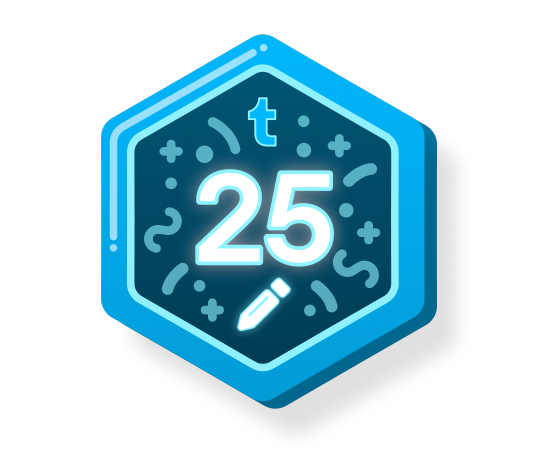
Hell yeah 25 posts!
Have another meme as a Thank-You. This time, it's an Avatar Roku meme!
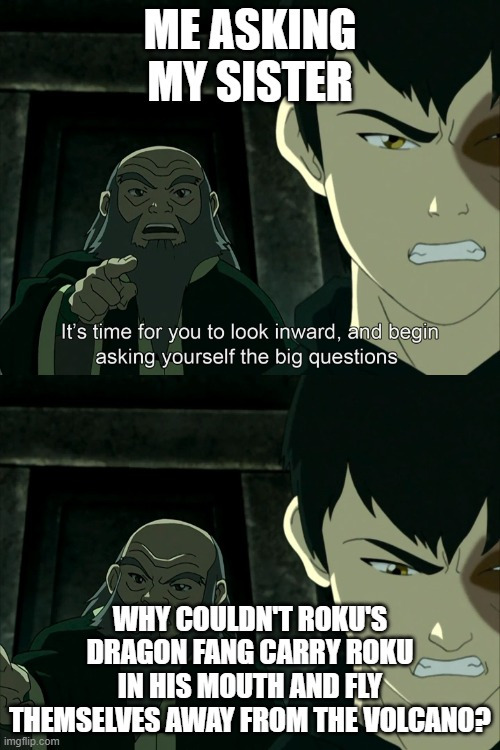
Genuine question. 🙋 I want your thoughts on this.
#25 posts#tumblr milestone#atla#atla memes#uncle iroh#zuko#roku#fang#to be fair to Fang#Roku DID inhale a lot of toxic gases from the volcanic eruption#so even if Fang DID fly Roku to safety#Roku would still die from inhailing all that smoke#mah rambles#daryaa celebrates#memelord
1 note
·
View note
Text
They should let Heatran use Toxic again
1 note
·
View note
Text

Achat-Druse
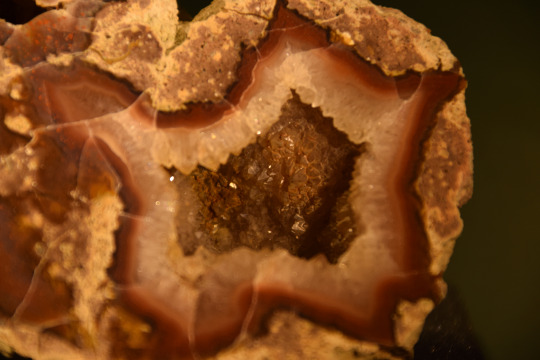
Auf einer Mineralienbörse in Klingmühl/Niederlausitz fand sich im Jahr 2022 diese schöne Achat-Druse.
Auf einer Mineralienbörse in Klingmühl/Niederlausitz fand sich im Jahr 2022 diese schöne Achat-Druse.
Durch eindringen von vulkanischen Gasen in Lava-Hohlräume nach einem Vulkanausbruch vor 280 Millionen Jahren entstanden die schönen zonierten Achate. Längst sind die giftigen Gase und Dämpfe verflogen. Geblieben ist die Schönheit der auskristallisierten Hohlräume.
#achat#minerals#klingmühl#niederlausitz#lower lusatia#east germany#Druse#nga#Mineralienbörse#gem#Silikat#Lava#vulkan#vulkanausbruch#volcanic eruption#gase#dämpfe#280 Millionen Jahre#Erdzeitalter#zoniert#Gestein
1 note
·
View note
Note
Whoa. What in God's name is the Great Dying? That sounds horrifying.
the Great Dying is the colloquial name for the End-Permian mass extinction event, which separates the Permian from the Triassic in the geological record.

and it's called that for a reason, because the Great Dying killed, no joke, 90% of all animals on planet Earth in the worst mass extinction of all time! the Earth before the Great Dying was an alien land full of crocodile relatives, mammal ancestors, and more weird fish than you could shake a reasonably-sized stick at.

<art src: Julius T. Csotonyi>
the world after the Great Dying was a blasted hellscape, with few survivors either in the sea or on land.
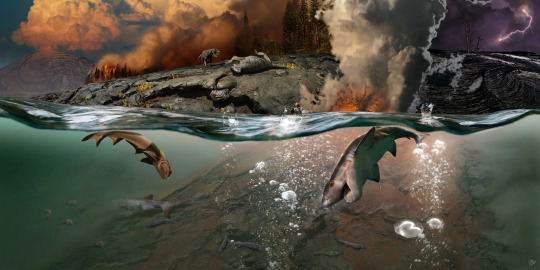
<art src: Julius T. Csotonyi>
one of those land-bound survivors was the ancestor of all mammals, and another was the first of the dinosaurs! the next geologic age, the Triassic, would see the rise of dinosaurs and pterosaurs and even seagoing ichthyosaurs to replace the multitude of lineages that fell during the Great Dying.
but what caused this chaotic event?
the death of a supercontinent, no joke.

Pangea was very much a thing at the time, but plate tectonics were starting to literally rip it apart at the seams. and when the seams split, a volcanic hellstorm was unleashed that hurled lava MILES into the air and covered the land in lava beds over a mile thick, releasing gigantic stores of carbon dioxide that dwarf the maximum amount humans could ever release by an order of magnitude! and also poisonous hydrogen sulfide gas. that will be important later.
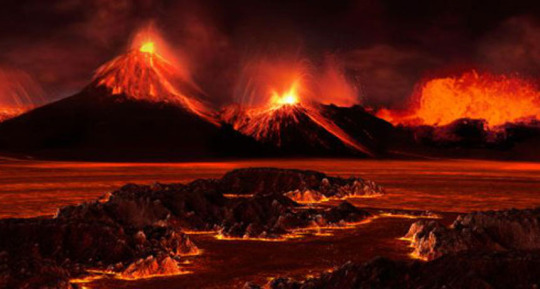
so what happened next was runaway global warming that rapidly turned the entire planet except for the poles completely uninhabitable. the ocean got so warm that it was as hot as a hot tub at the equator, which made the water unable to hold dissolved gases and sent the breathable oxygen levels in the ocean plummeting worldwide, suffocating basically everything in it. the land was covered in a haze of highly toxic gas and punishing heat that poisoned and baked animals alive, while the hot ocean waters may have fueled hurricanes the size of entire continents that ravaged both earth and sea down to the bedrock!
the whole fucking planet looked more like Venus than anything we'd recognize today.

so basically, this was the lowest point of animal life on Earth. it took many millions of years for our planet to recover, and we all should be thankful that, whatever humanity unleashes in the future, at least it won't be as bad as the Great Dying.
12K notes
·
View notes
Text
Why Isn’t Every Year the Warmest Year on Record?
This just in: 2022 effectively tied for the fifth warmest year since 1880, when our record starts. Here at NASA, we work with our partners at NOAA to track temperatures across Earth’s entire surface, to keep a global record of how our planet is changing.
Overall, Earth is getting hotter.
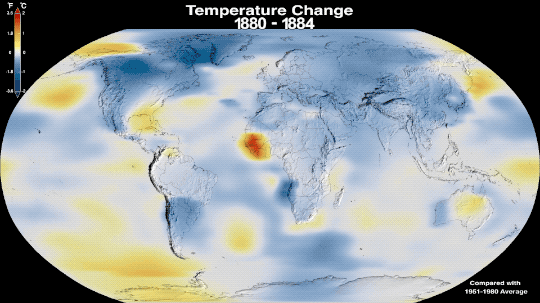
The warming comes directly from human activities – specifically, the release of greenhouse gases like carbon dioxide from burning fossil fuels. We started burning fossil fuels in earnest during the Industrial Revolution. Activities like driving cars and operating factories continue to release greenhouse gases into our atmosphere, where they trap heat in the atmosphere.

So…if we’re causing Earth to warm, why isn’t every year the hottest year on record?
As 2022 shows, the current global warming isn’t uniform. Every single year isn’t necessarily warmer than every previous year, but it is generally warmer than most of the preceding years. There’s a warming trend.
Earth is a really complex system, with various climate patterns, solar activity, and events like volcanic eruptions that can tip things slightly warmer or cooler.
Climate Patterns
While 2021 and 2022 continued a global trend of warming, they were both a little cooler than 2020, largely because of a natural phenomenon known as La Niña.
La Niña is one third of a climate phenomenon called El Niño Southern Oscillation, also known as ENSO, which can have significant effects around the globe. During La Niña years, ocean temperatures in the central and eastern Pacific Ocean cool off slightly. La Niña’s twin, El Niño brings warmer temperatures to the central and eastern Pacific. Neutral years bring ocean temperatures in the region closer to the average.
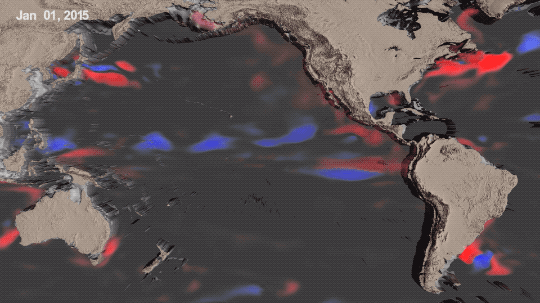
El Niño and La Niña affect more than ocean temperatures – they can bring changes to rainfall patterns, hurricane frequency, and global average temperature.
We’ve been in a La Niña mode the last three, which has slightly cooled global temperatures. That’s one big reason 2021 and 2022 were cooler than 2020 – which was an El Niño year.
Overall warming is still happening. Current El Niño years are warmer than previous El Niño years, and the same goes for La Niña years. In fact, enough overall warming has occurred that most current La Niña years are warmer than most previous El Niño years. This year was the warmest La Niña year on record.

Solar Activity
Our Sun cycles through periods of more and less activity, on a schedule of about every 11 years. Here on Earth, we might receive slightly less energy — heat — from the Sun during quieter periods and slightly more during active periods.
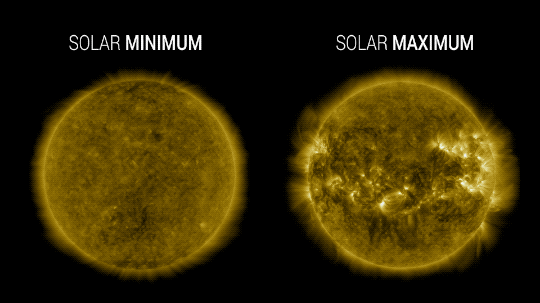
At NASA, we work with NOAA to track the solar cycle. We kicked off a new one – Solar Cycle 25 – after solar minimum in December 2019. Since then, solar activity has been slightly ramping up.
Because we closely track solar activity, we know that over the past several decades, solar activity hasn't been on the rise, while greenhouse gases have. More importantly, the "fingerprints" we see on the climate, including temperature changes in the upper atmosphere, don't fit the what we'd expect from solar-caused warming. Rather they look like what we expect from increased greenhouse warming, verifying a prediction made decades ago by NASA.
Volcanic Eruptions
Throughout history, volcanoes have driven major shifts in Earth’s climate. Large eruptions can release water vapor — a greenhouse gas like carbon dioxide — which traps additional warmth within our atmosphere.
On the flip side, eruptions that loft lots of ash and soot into the atmosphere can temporarily cool the climate slightly, by reflecting some sunlight back into space.
Like solar activity, we can monitor volcanic eruptions and tease out their effect on variations in our global temperature.
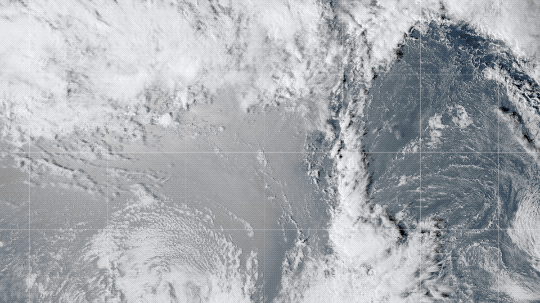
At the End of the Day, It’s Us
Our satellites, airborne missions, and measurements from the ground give us a comprehensive picture of what’s happening on Earth every day. We also have computer models that can skillfully recreate Earth’s climate.
By combining the two, we can see what would happen to global temperature if all the changes were caused by natural forces, like volcanic eruptions or ENSO. By looking at the fingerprints each of these climate drivers leave in our models, it’s perfectly clear: The current global warming we’re experiencing is caused by humans.
For more information about climate change, visit climate.nasa.gov.
Make sure to follow us on Tumblr for your regular dose of space!
3K notes
·
View notes
Photo


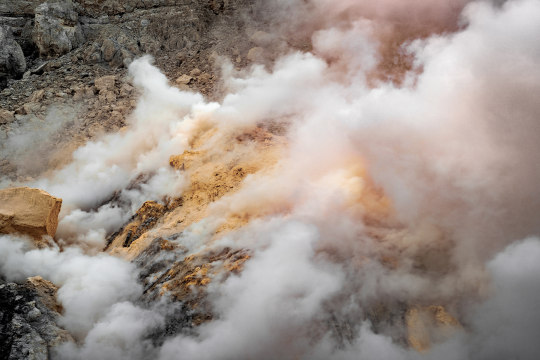


Ijen by Jonas Daley
With a diameter exceeding 1 kilometer and a depth of approximately 300 meters, the Ijen volcano crater has formed the Ijen Volcano Lake due to the presence of abundant sulfur salts and volcanic magma activity at the bottom. The lakebed is rich in sulfur deposits. Every year, local residents and workers climb the volcano and then collect sulfur from the lakebed. This is a strenuous and hazardous occupation, as workers labor in an environment saturated with toxic gases, traversing the steep slopes. The sulfur mined by them is primarily used in the production of fertilizers and industrial products such as chemicals.
104 notes
·
View notes
Text
Planetary Life is a game about planets, life and evolution.
Wishlist now on Steam:
Join Discord:
https://discord.gg/rN4KFgkVu8
Create and design plants and creatures for your planet, make them evolve and expand looking for the balance for a perfect ecosystem.
Make your creatures smart enough to found civilizations and conquer outer space.
PLANETS
Control a planet with the multiple tools available. Let the tectonic plates shape the mountains and seas, modify the climate, the heat of the nucleus, the volcanic activity, the gases of the atmosphere, etc... until shaping the home of your creatures.
GEOSPHERE AND ATMOSPHERE
Change core heat and volcanic activity to shape your planet terrain through volcanoes.Manipulate rainfalls, cloud and surface albedo to change the climate.
CREATURES AND EVOLUTION
Create creatures and evolve them from simple organisms to intelligent beings. Modify their parts and abilities, help them or let them fight for survival on their own.
CIVILIZATIONS
When your creatures reach sufficient intelligence they will organize themselves into tribes and later flourish into civilizations. Manage and help them in the battle for technology to conquer space.
#gamedev#procedural#planet#game#sim#simulation#indiedev#game development#videogame#simearth#sim life#spore#creatures#godot engine
262 notes
·
View notes
Text
I'm back with another sculpture! To be completely honest, this one was a real struggle for me to work out, idea wise. I love working abstractly (see earlier pieces!) but for this one our prompt in class was "objects and identity." We were asked to cast an object from life, and use it to speak to some aspect of ourselves that we want to explore. Not only am I an extremely closed book (pour one out for my therapist) but I'm also really not that interested in replicating objects?
So... I sort of cheated. This isn't *really* a cast of VHS tapes (although I did try to do that, and it failed miserably) but I'm still pleased with the outcome. Sound on for what I think is the best part — the pleasing and/or sinister snick snick snick sound of the tape unspooling and piling up.
If you like long, corny artist statements, boy howdy do I have one for you!
~~ GEODE ~~
My day job is as a journalist, and while I find a lot of the posturing that journalists do about our role as storytellers to be pretentious and often egotistical, I also can't deny that I got into this because I love to see into people's lives. Why do people do what they do? Why do we make the choices we make? How did we get here, as individuals and as a collective?
Much of journalism is about the big moments — wars and chaos and game changing plays. But those don't come out of nowhere. They come from a history, both personal and communal. We are products of our childhoods, our cultures, our teachers, our parents. We come from places that have smells and sounds and textures. And we document those things — and here I don't mean "we" journalists, I mean "we" as people. Humans have, for our entire history, recorded ourselves in one way or another. We write on walls, we tell each other stories, we come up with words that have deep meanings that stretch back into time.
Some journalists see their job as speaking truth to power. Or telling the important stories in the face of chaos and misinformation. Or staking a claim to truth, and defending it. All of that is true, of course. But when I think about my job I don't think about those things. I think about excavation. About telling the story in such a way that you can feel the texture of the people in it. I think of stories like geodes.
Do you know how a geode forms? They start with a volcanic eruption. Lava flows from a hot, angry vent, and mixes with the gases in the air. Most of the time, those gases don't stay put — they escape into the air and go off to become the wind in your hair, or carry pollen, or sweep under a bird's wing. But sometimes, bubbles of gas can't escape the boiling weight of the lava and become trapped. As the lava cools, those bubbles remain. It is only then — held tight and encased in cooling rock — that the crystals characteristic of geodes form.
There is something sad about opening a geode. It can reveal a great beauty, but it is also inherently destructive. You are taking a hammer to something hard and protected and asking it to open, to be seen, to be commented on. Not all geodes want to open. Not all geodes should be opened, perhaps. Not all geodes are beautiful inside. How do you know when to break one, and when to leave it be?
Once you break a geode, you open the crystals up to damage. UV light can bleach the colors inside and the oils on your skin can slowly eat away at the glittering growths.
I think a lot, as a journalist, about the stories that we lose when people die. The small things that they knew — the color of a lover's hair, the name of their neighborhood dog, the true identity of a soldier — that go to the ground with them. I have to stop myself from buying home movies when I see them at garage sales and thrift shops — each one, to me, a geode. Inside they might contain nothing, or everything. Wrapped tight in metallic film they recorded things people thought were important, things people wanted to remember. Trapped in plastic and now, broken open.
My piece is a VHS geode. I have broken it, and it is unspooling, and we are forgetting. It is beautiful and terrible all at once.

#sculpture#moving sculpture#kinetic sculpture#plaster#plaster casting#VHS#geode#cheesy artist statements#art class#art
123 notes
·
View notes
Text
A team of geologists and planetary scientists from the California Institute of Technology, the University of California Santa Cruz, New York University, and NASA Goddard Space Flight Center reports evidence that Io's volcanic activity has been ongoing since the beginning of the solar system. In their study, published in the journal Science, the group studied sulfur isotopes in Io's atmosphere to determine how long the moon has been volcanically active.
Prior research has shown that the solar system is approximately 4.5 billion years old and that Jupiter's moon, Io, is the most volcanically active body in the solar system. But until now, researchers did not know how long the moon has been active. To find out, the research team used data from ALMA to analyze the gases present in Io's atmosphere.
Continue Reading.
46 notes
·
View notes
Text
i present: small and non-verbal but very funny star wars moments:
ep. V: the empire strikes back--the millenium falcon achieves hyperspeed again, despite the imperials' best plans to the contrary. admiral piett and his men are terrified of vader's reaction, all trying to stay out of his path. but he's still too busy brooding on his loss of luke to even force-choke anyone. that's how thrown off he was by his newly-mutilated son running away from him!



the sole exception to this collective terror being this guy, so intent on his own important work, that he doesn't even notice his scary boss until darth vader has walked right past him.
ep. III: revenge of the sith--padme's droids somehow getting her unconscious body back on her ship.
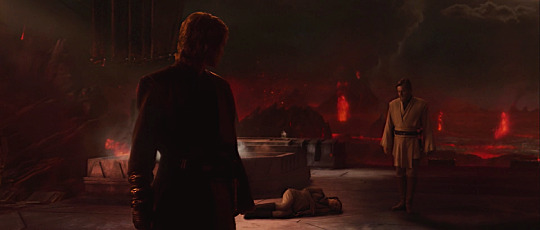


in the novelisation, r2-d2 just drags her up the ramp with his gadgetry, but in the script it's c-3po who carried her up bridal style. which would be impossible to film when 3po could barely manage to move around under his own weight. what makes it really funny for me is that there was no need for any of this. why not just have obi-wan pick her up as he's hurrying outta there after failing to kill her husband? i mean, it's surely not good to be lying out in the open on a volcanic world with poisonous gases, but it wouldn't be good for obi-wan running around out there either, and this lady was about to have broken heart as her only known cause of death. when has science ever held back star wars? and i can't imagine that being dragged by wires from artoo or dropped every few steps by threepio could've been too good for her body either. just makes for an absurd little (offscreen) background detail amid the tragedy of the end of padme's life, imho.
ep. IV: a new hope--obi-wan vanishing into thin air when struck down and vader's (very understandable) bafflement afterward.


by this point in the second screencap, luke is shooting at him in retaliation and the stormtroopers are all shooting back at luke, but anakin is still dealing with this unprecendented vanishing and busy searching for any corporeal remains of obi-wan kenobi with his boot. "where did you go, my old master? how could this happen? i wasn't done fighting with you yet."
ep. V: the empire strikes back--vader inviting lando calrissian, chewbacca, han solo, and princess leia to share a meal with him and boba fett, before taking chewie, han, and leia prisoner and torturing han.


i think a lot of people must assume there was no actual meal, but it's not like vader had to go to all that trouble in the first place of setting out an entire banquet table with proper containers and utensils. just because that was lando's pretext to bring them to vader does not necessitate actually having a table set. darth vader could have had them led into any other room with boba fett and stormtroopers waiting to just arrest them right away. instead, as we can see in the second screencap, (over lando's shoulder and leia's bun), vader did sit down at the head of the table, waiting for his prey to join him. and i swear, in one of the earlier drafts of empire's screenplay there is actually a scene showing their awkward meal together. or rather, han and leia being served food and drinks while darth vader just sits there, watching evilly, explaining his great villainous plan to use them to trap luke. it's like dr. evil making austin and vanessa sit down at his table in the first austin powers movie. darth vader really did always live for drama
ep. VI: return of the jedi--leia telling han that she loves luke, but not that way. he's her brother, silly! as if this is something they all knew all along, with zero follow-up explanation. you can just see han wordlessly processing this bombshell of brand new information through his facial expressions alone. (this lasts so long that i wouldn't even count it were it not likely overshadowed by everything else in the ending of rotj.)
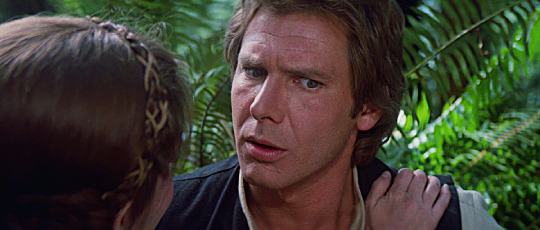
wh-what did you say? your brother? since when?

wait-wait-wait. i've seen you mouth kissing luke right in front of me before. i'm so confused now.

just what kind of weirdo family have i gotten myself mixed up with here?

oh, well, she's only kissing me now. that's good enough, i guess. maybe?

hey, as long as you do love me and luke in different ways ...

i don't know much about families, but i've heard they all have their weird traditions. so who am i to judge you, babe? as long as we're together now, that's all that matters.
#swedit#star wars#anakin skywalker#darth vader#padme amidala#lando calrissian#chewbacca#han solo#leia organa#yes i did use very specific adjectives to exclude most of the st#tho i do think there's some funny intentional and more overt humor in the jj saga#tlj was more marvel-like humor which was its real greatest sin#tumblr won't let you do a numbered list in descending order so just imagine it's a top 5 that way#(c)lsb
91 notes
·
View notes
Text
Lore for the Ash clans of Pandora
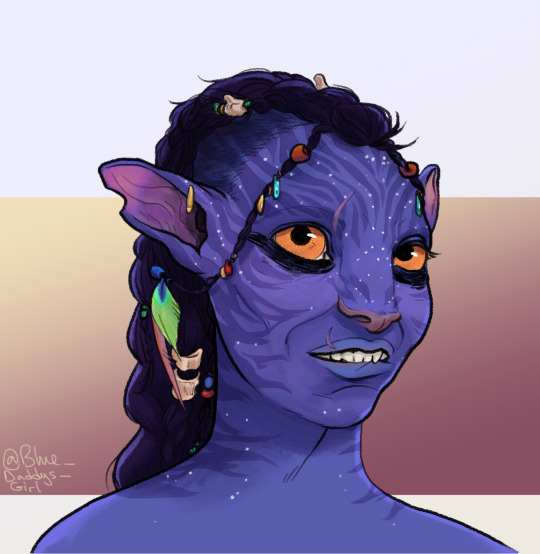
Meet Kesa of the txepìva
Kesa is one of the ash Na'vi, from a txepìva clan. She lives along an enormous volcanic fault with constant eruptions. The soil is very rich there, but due to the instability of their home, Kesa's people are nomadic. As a result, there can be fierce competition for resources.
Kesa is a Claimer. She scouts ahead of her clan with a small band in search of old or new oasis that will provide foraging, hunting, and water. If they encounter a party from another clan, they will engage in ritualistic combat.
As a warrior, it's Kesa's speciality. She's an alright hunter, but she was trained to fight and kill other Na'vi specifically. If the claiming party makes a strong, frightful display, they might win the location and chase off the other tribe. If not, they'll alert their own to divert their path.
If things are desperate enough, clans might face off in actual combat. Conditions are much harsher along the volcanoes.
Txepìva Na'vi have darker skin with purplish stripes. Due to frequent low visibility caused by ash clouds and smoke, they have larger eyes, of a deep amber-red colour, and larger ears than their forest counterparts. Their nostrils are also wider, but can be closed completely shut. They share a good breathing capacity with the Metkayina, as they may cross patches of toxic gas and have to get under cover/upwind. Their sense of smell is the most acute of all Na'vi.
They don't practice war paints, but they make thick mixtures they smear around their eyes to help combat irritation from ash and gases and wards against insects.
Unlike other clans, Txepìva Na'vi have three leaders. One leads the clan according to memory. They keep track of their progress through the year, and the movements of the volcanoes and lava flows. They work closely with the Claimers/Scouts, as does the war leader. That leader has a more minor role, activated only when the clan decides to fight. At such times only the war leader's decisions are followed, to reduce confusion and division. The final leader is their Tsahìk.
Txepìva clans have no central leader, the way Tonowari has influence over other villages. How peaceful they are entirely depends on how resource rich the environment is at the time.
The Txepìva use no ikran or pa'li. Food is just too scarce and they aren't native to the volcanic plains. However they hunt alongside cousins of the nantang (viperwolf) that live in small family packs, are larger and adapted to desertic conditions. They also use birds, mated pairs that travel with them and use tsaheylu to communicate what they've seen from the sky. It's not uncommon for a young couple of Claimers to be gifted a pair of such birds, helping them to work in tandem over great distances, using them a lot like humans would messanger pigeons.
As you may imagine, Txepìva Na'vi are extremely powerful distance runners. They're one of the few Na'vi to favour shoes, which they make by braiding a fire resistant plant, and use to tread over lava flows that aren't fully cooled and over obsidian ground. They also value metal tools and have several RDA issue items in constant rotation among them as they get bartered and borrowed.
The Txepìva are masters of using fire to hunt, cornering animals and using smoke to asphyxiate, but also poison. They brew strong toxins and apply them to arrows (they use short, sturdy bows), or blow darts. When you don't have a lot of prey, you have to kill it, and fast. Though they remove contaminated flesh around the wound, Txepìva meat has a reputation for being unpalatable to strangers because of remaining toxins. The ash people have long since gained immunity and don't notice it.
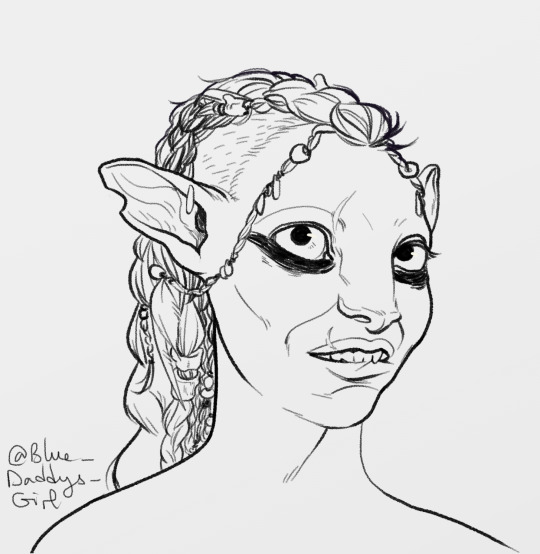
Have some lineart~
#avatar lore#all 100% made up#use freely and build on it#credit appreciated#asks open for more#avatar 2#avatar the way of water#avatar 3#which will disprove all of this#avatar oc#na'vi#na'vi oc#fem na'vi#fanart#na'vi life#my art#james cameron gimme a job#please
265 notes
·
View notes
Text

Image Suburban Men. Mount Kelimutu in Kelimutu National Park and its trio of multicolored crater lakes has to be one of the coolest sights on the island of Flores, Indonesia.
These are three volcanic lakes that are known to regularly change colors (to blue, green, pink, or brown!) because of changes in the underlying gases and elements. The Kelimutu lake colors change up to 6 times per year.
32 notes
·
View notes
Text
Alala, third planet of the star Areëos, was first logged by the survey ship I Would Be River Water as supporting life, and certainly it does, but not much of it. Mats of xanthophyllic algae descended from that brought by the Goldsowers approximately 12.4 mya coat the shores of its shallow oceans, and lichenous yellow splotches march across the land, chewing basalts and olivines into primordial soil, but multicellular heterotrophic life seems limited to various gelatinous worms burrowing through the oceanic silt. Alala is young, as planets go, and its crust thin; fumaroles dot its surface, and in and around their chimneys extremophilic bacteria breed, hitch rides on the glittering sooty plumes of volcanic gases that tidal forces from Alala's single moon, Carnyx, coax out as it passes overhead, and are then whipped into the howling 500kmph winds that gave the planet its name.
Other features of note in the Areëos system include the Ring of Keres, an asteroid belt seven or eight times denser than that of Sol, likely the remains of a planet torn apart by the gas giant Homados, as well as Homados itself and its host of moons - of greatest interest to I Would Be River Water and later ships Becoming The Glass Castle and Intransigent Star was Bástya, the large and rocky base of operations for the Goldsowers as they began the work of habitiforming Alala for their own purposes. The ruins here are of the Late Goldsower Style, very well preserved in Bástya's thin atmosphere and the plymatter only just beginning to show signs of deviation. Still requiring further study are many of the other moons of Homados and its brother Kratos, as well as the planets beyond them, and indeed the planets inward of Alala as well.
54 notes
·
View notes